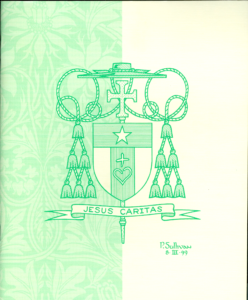The following is the description in Heraldic Terms of Bishop Thomas J. Olmsted’s Coat of Arms, designed and written by Deacon Paul J. Sullivan.
Blazon. Arms impaled.
Dexter: Azure, issuant from a mountain Argent, a phoenix, or, the flames Gules; in chief a cross formy fitchée of the last.
Sinister: Argent, a pale Gules, charged with a heart and cross of the Jesus Caritas Fraternity of the first; on a chief Azure a star of the first.
Significance
The Episcopal heraldic achievement, or, as it is more commonly known, the bishop’s coat of arms, is composed of a shield with its charges (symbols) and the external ornaments. The shield, which is the central and most important feature of any heraldic device, is described (blazoned) in 12th century terms that are archaic to our modern language and this description is presented as if being given by the bearer with the shield being worn on the arm. Thus, where it applies, the term “dexter” (right) and “sinister” (left) are reversed as the device is viewed from the front.
By heraldic tradition, the arms of the bishop of a diocese, called the “Ordinary,” are joined to the arms of his jurisdiction, seen in the “dexter impalement” (left side of the shield); in this case, the Diocese of Phoenix.
These arms are composed of a blue field on which is placed a silver (white) mountain to represent Camelback Mountain, a significant aspect of the backdrop of the See City. Arising from the mountain as a gold (yellow) bird that is coming forth from red flames to represent the mythological phoenix, that arose from the ashes, and for which the See City of Phoenix is named. Above the phoenix is a gold cross formy fitchée (three arms of a cross and one resembling a spike), which is taken from the arms of the Diocese of Tucson to signify that it was from the territory of Tucson that the Diocese of Phoenix was carved in 1969.
For his personal arms, Bishop Olmsted has retained the design that was adopted at the time he was selected to be Coadjutor Bishop of Wichita and which he used during his tenure as Bishop of Wichita. The design reflects His Excellency’s life as a priest and as a bishop.
The design is based on the arms of the Diocese of Lincoln, Neb., the Bishop’s home diocese, and the design is in the national colors of red, white and blue to honor our nation’s 16th President, Abraham Lincoln, for whom the city is named.
In the lower part of the design, the silver field is divided by a red pillar, known as a “pale,” and this pale is charged with the stylized heart and cross of the Jesus Caritas Fraternity.
The fraternity is a form of school of spirituality for clergy and laity that promotes the ideals expressed in the bishop’s episcopal motto, namely that it is in, for and through the “Love of Jesus” that the world is redeemed and humanity is made one again with God.
The white portions on either side of the red pale represent the disciples, sent in pairs by Jesus, to proclaim the Gospel of Life. This also recalls that Bishop Olmsted’s name, Thomas, means “twin.” The upper portion of the design contains a silver (white) star on a blue field to honor the Blessed Virgin Mary.
As mentioned, for his motto, Bishop Olmsted uses the phrase Jesus Caritas. This phrase, which is the title and name of his ecclesial fraternity, expresses his intention, throughout his ministry as a shepherd of God’s fold, to be guided personally by the “Love of Jesus” and to help others to know and to rejoice in that love.
The devise is completed with the external ornaments which are a gold processional cross, which is placed in back of the shield and which extends above and below the shield, and a pontifical hat, called a “gallero,” with its six tassels, in three rows, on either side of the shield, all in green. These are the heraldic insignia of a prelate of the rank of bishop by instruction of The Holy See of March 31, 1969.
– Deacon Paul J. Sullivan


